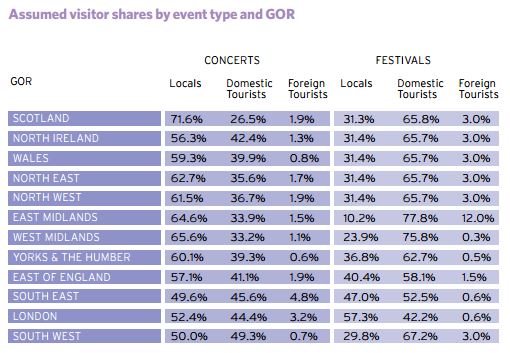There’s been a new report published by UK Music, the consortium that supports the UK music industry’s political needs.
Wish You Were Here 2015 highlights the importance of the music industry to tourism and that audience’s spending power. It was released on Monday and has generated a decent amount of press coverage.
It’s a chunky piece of work from Oxford Economics, and gets right into the detail of each region’s importance, backed up with detailed case studies. But the headline figures have a couple of numbers that either feel like they’ll be misinterpreted, or are overly precise.
“Music tourism numbers in the UK increased by 34% between 2011 and 2014, with 9.5 million people travelling to music events in 2014. These music tourists, attending live concerts and festivals in the UK, helped generate £3.1 billion pounds in direct and indirect spend.”
…
“This increase in music tourism provides a huge boost to employment throughout the country, with 38,238 full time jobs in 2014 sustained by music tourism in the UK.”
(My emphasis)
The report is further supported by quotes from the great and the good including the new Culture Secretary, John Whittingdale:
“It’s fantastic news that our music industry drew in 9.5 million tourists last year but it’s no surprise. British music is legendary around the world and continues to go from strength to strength, with UK artists now accounting for one in seven albums sold worldwide…”
(My emphasis again)
Goodness. That’d seem to imply a lot of foreign tourists we’re getting coming purely to see music!
Er, well. That might be the impression you take from the report, but that’s not actually what it says.
If you dive into the methodology, you’ll come across this table which highlights where those tourists come from:
That table shows that foreign tourists make up a relatively small percentage of overall visitors to festivals – mostly below 3% (the outlier seems to be the East Midlands where perhaps the Download Festival does indeed attract significant overseas tourists). For regular concerts, the foreign numbers plummet further.
UK Music has categorised attendees to these events as “locals”, “domestic tourists” and “foreign tourists.” And it’s the first two camps that are biggest. Furthermore, they’ve used a definition of ‘3 x your commute’ to determine whether you’re a local or not.
So if you live in London and going to the V Festival at Chelmsford? “Domestic Tourist.”
Live in Milton Keynes and going to see Dave Grohl and co. at Wembley at some point in the future when their gigs get re-arranged? “Domestic Tourist.”
Indeed what this report really says to me is that the live music industry is flourishing and there are now lots of festivals and big arena gigs that inevitably require people to travel to get to. And of course they spend some money getting there.
But let’s try and put this in perspective. I’m mixing methodologies, and probably periods, but you’ll get an idea.
VisitBritain says that there were 34.4m foreign tourists in 2014.
Now the UK Music report doesn’t provide an overall percentage of tourists who are foreign, so I’ve extrapolated using the percentages in the table above. This will provide a wrong number (it takes no account of the relative sizes of audiences in different regions, or between concerts and festivals), but it’s better than nothing.
So if we ignore locals, we end up with an average of 95.7% “domestic tourists” and 4.3% “foreign tourists.”
UK Music says that there are 9.5m “music tourists” in total, so that gives us 405,000 “foreign tourists.”
But there are 34.4m foreign tourists in total. So our very rough calculations suggest that a little over 1% of all foreign tourists to the UK come for the music.
Not to be sniffed at, but perhaps not what you’d get from reading the coverage of this report.
Here are a couple of examples with incorrect and correct reporting:
Digital Spy – “According to industry body UK Music, 9.5m visitors from abroad attended music events in the UK last year…”
BBC News – “Across the UK 9.5 million people travelled to music events.”
The other number I wanted to highlight was the extraordinarily precise figure for the number of employees these tourists support. The report says 38,238. If you give a number with that precision, it suggests that you have all their names and addresses. Surely they should just say “38,000” or “over 38,000”?
In any case, let’s look a little more deeply at this statistic. According to the methodology, the numbers are calculated based on Full Time Equivalent (FTE) employees and the amount of Gross Value Added (i.e. additional spend) across a number of sectors and by region. FTE is a standard measurement of labour and takes account of part-time working and job-sharing.
My issue here is that surely most of these jobs are very casual indeed? Summer festivals are full of students earning money, and a very transient labour force in general: security, caterers and so on. While arena concerts might be a little more evenly spaced throughout the year, providing a very specific number of jobs suggests a level of accuracy that just isn’t there.
In fact it’s likely to be a much bigger number of people getting some employment for some time. But the news release actually says “38,238 full time jobs” and that simply can’t be the case.
Full Time Equivalent is not the same as full time jobs.
What kind of work do you think that person has on a wet Monday in November? They’re not employed by Glastonbury/Festival Republic, that’s for sure.
I’m not decrying the work necessarily. It’s terrific for students and others to have opportunities like this for relatively short-term shifts. But let’s not over-egg the pudding. Indeed I’d hazard a guess that some agencies are offering “zero-hours” contracts to employees…
Thanks to Paul Flower for pointing me towards this report and suggesting all was not what it seemed.

